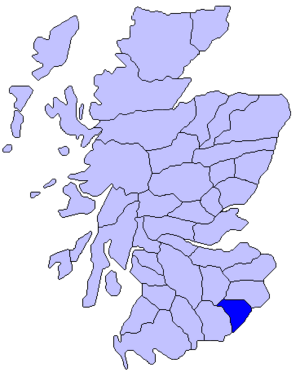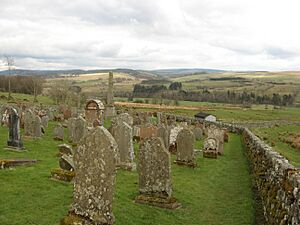Liddesdale facts for kids
Quick facts for kids Liddesdale |
|
|---|---|
Liddesdale |
|
| Country | Scotland |
| Sovereign state | United Kingdom |
| Dialling code | 013873 |
| Ambulance | Scottish |
| EU Parliament | Scotland |
| UK Parliament |
|
| Scottish Parliament | |
Liddesdale is a beautiful valley in southern Scotland. It follows the path of the Liddel Water river. This valley stretches for about 21 miles (34 km) from near Peel Fell to the River Esk.
A railway line, called the Waverley route, runs through the valley. You can also find the Catrail, or Picts' Dyke, at the top of the valley. This is an ancient earthwork.
Contents
Liddesdale's History
Liddesdale was once an important historic area in Scotland. It shared borders with other regions like Teviotdale to the east and Annandale to the west. To the north was Tweeddale, and to the south, across the border, was Cumberland in England.
Part of Roxburghshire
This area was first part of a "Sheriffdom" called Roxburgh. A sheriffdom was like a large district where a sheriff was in charge of law and order. Later, Liddesdale became part of the County of Roxburgh. This was one of the many counties in Scotland.
A big change happened in 1889 with a new law. This law created a standard system for local councils across Scotland. It helped to organize how towns and counties were managed.
Roman Road Connection
Some people believe that Liddesdale forms the northern end of an old Roman road called the Maiden Way. This road was built by the Romans when they were in Britain.
Ancient Towers and Outlaws
Long ago, many small castles called peel towers stood along the river and its smaller streams. These towers were often used by "freebooters" or outlaws. These were people who lived outside the law and sometimes raided nearby areas.
Most of these old towers have disappeared or are now just ruins.
- Larriston Tower belonged to the Clan Elliot.
- Mangerton, which is mostly gone, belonged to the Clan Armstrong.
- Park Tower was home to "Little Jock Elliot", a famous outlaw.
Hollows Tower, which belonged to another outlaw named Johnnie Armstrong, is still in good condition. You can find it about 4 mi (6 km) south of Langholm on the A7 road.
Hermitage Castle
The most interesting place in Liddesdale is Hermitage Castle. This is a huge, strong castle with an H-shape. It is one of the oldest castles still standing in Scotland. It sits on a hill overlooking Hermitage Water, a stream that flows into the Liddel.
Castle History
Hermitage Castle was built in 1244 by Nicholas de Soulis. The English captured it during the time of King David II. But it was later taken back by Sir William Douglas. The king then gave the castle to Sir William.
In 1492, Archibald Douglas, the 5th Earl of Angus, traded Hermitage Castle for Bothwell Castle. He exchanged it with Patrick Hepburn, 1st Earl of Bothwell. Eventually, the castle came under the care of the Duke of Buccleuch, who helped stop it from falling apart further.
Famous Visitors
Hermitage Castle has seen some important historical events.
- In 1342, Sir Alexander Ramsay of Dalhousie was held here by Sir William Douglas.
- Mary, Queen of Scots, visited James Hepburn, 4th Earl of Bothwell, at the castle. This happened after Bothwell was injured in a fight in 1566.
Ninestane Rig
To the east of Hermitage Castle is a hill called Ninestane Rig. It is about 943 ft (287 m) high. The hill is about 4 mi (6 km) long and 1.6 mi (3 km) wide.
The name "Ninestane Rig" comes from a circle of nine large stones that once stood there. Only five of these stones remain today. There's an old story that a cruel lord named William de Soulis was boiled in a copper pot on two of these stones in 1320.
People and Places
James Telfer (1802–1862) was a writer of ballads, which are like old songs that tell stories. He was born in the parish of Southdean. For several years, he worked as a schoolmaster in Saughtree, which is near the top of the Liddesdale valley.
The main castle of the lords of Liddesdale used to stand near where Hermitage Water and the Liddel river meet. The village of Newcastleton grew up around this spot.



